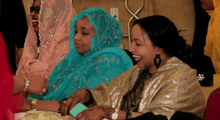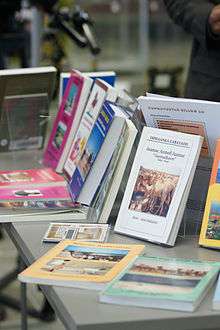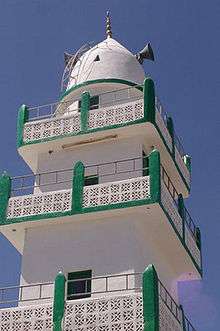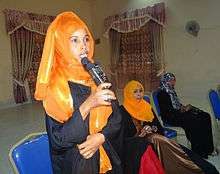Culture of Somalia
 |
| Part of a series on the |
| Culture of Somalia |
|---|
| Culture |
| People |
| Religion |
| Language |
| Politics |
|
The culture of Somalia is an amalgamation of traditions in that were developed independently and through interaction with neighboring and far away civilizations, including other parts of Africa, Northeast Africa, the Arabian Peninsula, India, and Southeast Asia.[1]
Overview

The cultural diffusion of Somali commercial enterprise can be detected in its exotic cuisine, which contains Southeast Asian influences. Due to the Somali people's passionate love for and facility with poetry, Somalia has often been referred to as a "Nation of Poets" and a "Nation of Bards", as, for example, by the Canadian novelist Margaret Laurence.[2] Somalis have a story-telling tradition.
Somalis have a rich musical heritage centered on traditional Somali folklore. Most Somali songs are pentatonic; that is, they only use five pitches per octave in contrast to a heptatonic (seven note) scale such as the major scale.
Somali art is the artistic culture of the Somali people, both historic and contemporary. These include artistic traditions in pottery, music, architecture, wood carving and other genres. Somali art is characterized by its aniconism, partly as a result of the vestigial influence of the pre-Islamic mythology of the Somalis coupled with their ubiquitous Muslim beliefs.
Languages
The Somali language is the official language of Somalia. It is a member of the Cushitic branch of the Afro-Asiatic language family, and its nearest relatives are the Afar and Oromo languages. Somali is the best documented of the Cushitic languages,[3] with academic studies of it dating from before 1900.

Somali dialects are divided into three main groups: Northern, Benaadir and Maay. Northern Somali (or Northern-Central Somali) forms the basis for Standard Somali. Benaadir (also known as Coastal Somali) is spoken on the Benadir coast from Adale to south of Merca, including Mogadishu, as well as in the immediate hinterland. The coastal dialects have additional phonemes which do not exist in Standard Somali. Maay is principally spoken by the Digil and Mirifle (Rahanweyn) clans in the southern areas of Somalia.
Since Somali had long lost its ancient script,[4] a number of writing systems have been used over the years for transcribing the language. Of these, the Somali alphabet is the most widely used, and has been the official writing script in Somalia since the government of former President of Somalia Siad Barre formally introduced it in October 1972.[5]
The script was developed by the Somali linguist Shire Jama Ahmed specifically for the Somali language, and uses all letters of the English Latin alphabet except p, v and z. Besides Ahmed's Latin script, other orthographies that have been used for centuries for writing Somali include the long-established Arabic script and Wadaad's writing. Indigenous writing systems developed in the twentieth century include the Osmanya, Borama and Kaddare scripts, which were invented by Osman Yusuf Kenadid, Sheikh Abdurahman Sheikh Nuur and Hussein Sheikh Ahmed Kaddare, respectively.[6]
In addition to Somali, Arabic is an official national language of Somalia.[7] Many Somalis speak it due to centuries-old ties with the Arab World, the far-reaching influence of the Arabic media, and religious education.
English is also widely used and taught. Italian used to be a major language, but its influence significantly diminished following independence. It is now most frequently heard among older generations who were in contact with the Italians at that time or later as migrants into Italy. Other minority languages include Bravanese, a variant of the Bantu Swahili language that is spoken along the coast by the Bravanese people.
Religion
With few exceptions, Somalis are entirely Muslims,[8] the majority belonging to the Sunni branch of Islam and the Shafi`i school of Islamic jurisprudence, although some are also adherents of the Shia Muslim denomination.[9] Sufism, the mystical dimension of Islam, is also well-established, with many local jama'a (zawiya) or congregations of the various tariiqa or Sufi orders.[10] The constitution of Somalia likewise defines Islam as the religion of the Somali Republic, and Islamic Sharia as the basic source for national legislation.[11]
Islam entered the region very early on, as a group of persecuted Muslims had, at Prophet Muhummad's urging, sought refuge across the Red Sea in the Horn of Africa. Islam may thus have been introduced into Somalia well before the faith even took root in its place of origin.[12]
Although Somali women were initially excluded from the many male-dominated religious orders, the all-female institution Abay Siti was formed in the late 19th century, incorporating Somali tradition and Islam.
In addition, the Somali community has produced numerous important Islamic figures over the centuries, many of whom have significantly shaped the course of Muslim learning and practice in the Horn of Africa, the Arabian Peninsula, and well beyond. Among these Islamic scholars is the 14th century Somali theologian and jurist Uthman bin Ali Zayla'i of Zeila, who wrote the single most authoritative text on the Hanafi school of Islam, consisting of four volumes known as the Tabayin al-Haqa’iq li Sharh Kanz al-Daqa’iq.
Clan and family structure
The clan groupings of the Somali people are important social units, and clan membership plays a central part in Somali culture and politics. Clans are patrilineal and are divided into sub-clans and sub-sub-clans, resulting in extended families.[13]
Major Somali clans include:
For more about clan structure visit the Demographics of Somalia
Attire
Men

When not dressed in Westernized clothing such as jeans and t-shirts, Somali men typically wear the macawis (ma'awiis), which is a sarong-like garment worn around the waist and a large cloth wrapped around the upper part of their body. On their heads, they often wrap a colorful turban or wear the koofiyad, an embroidered taqiyah.
Due to Somalia's proximity to and close ties with the Muslim world, many Somali men also wear the Thawb (khamiis in Somali), a long white garment common in the among Muslims.[14]
Traditionally Somali attire for men consisted of two sheets(often plain white), one draped over the shoulder and the other tied around the waist. The sheet sometimes had embroidery, patterns or laced borders. This attire is no longer common though it can be found in some rural communities.
Women

During regular, day-to-day activities, women usually wear the guntiino, a long stretch of cloth tied over the shoulder and draped around the waist. The guntiino is traditionally made out of plain white fabric sometimes featuring with decorative borders, although nowadays alindi, a textile common in the Horn region and some parts of North Africa, is more frequently used. The garment can be worn in many different styles and with different fabrics.
For more formal settings such as weddings or religious celebrations like Eid, women wear the dirac, a long, light, diaphanous voile dress made of cotton or polyester fabric. It is worn over a full-length half-slip and a brassiere. Known as the gorgorad, the underskirt is made out of silk and serves as a key part of the overall outfit. The dirac is usually sparkly and very colorful, the most popular styles being those with gilded borders or threads. The fabric is typically acquired from Somali clothing stores in tandem with the gorgorad.
Married women tend to sport head-scarves referred to as shash, and also often cover their upper body with a shawl known as garbasaar. Unmarried or young women, however, do not always cover their heads. Traditional Muslim garb such as the jilbab is also commonly worn.
Additionally, Somali women have a long tradition of wearing gold and silver jewelry, particularly bangles. During weddings, the bride is frequently adorned in gold. Many Somali women by tradition also wear gold necklaces and anklets. The xirsi, an Islamic necklace likewise donned in Ethiopia and Yemen, is frequently worn.
Art

Somali art is the artistic culture of the Somali people, both historic and contemporary. These include artistic traditions in pottery, music, architecture, wood carving and other genres. Somali art is characterized by its aniconism, partly as a result of the vestigial influence of the pre-Islamic mythology of the Somalis coupled with their ubiquitous Muslim beliefs. However, there have been instances in the past of artistic depictions representing living creatures such as the golden birds on the Mogadishan canopies, the camels and horses on the ancient rock paintings in northern Somalia, and the plant decorations on religious tombs in southern Somalia, but these are considered rare. Instead, intricate patterns and geometric designs, bold colors and monumental architecture were the norm.
Additionally, henna is an important part of Somali culture. It is worn by Somali women on their hands, arms, feet and neck during weddings, Eid, Ramadan, and other festive occasions. Somali henna designs are similar to other horn of Africans, often featuring flower motifs and triangular shapes. The palm is also frequently decorated with a dot of henna, and the fingertips are dipped in the dye. Henna parties are usually held before the wedding ceremony takes place.
Customs and courtesies
Somalis warmly greet each other with handshakes, but shaking hands with the opposite sex is avoided but some choose to do so. Common verbal greetings include:
- assalamu alaikum (Peace be upon you)
- maalin wanaagsan (good day/morning)
- galab wanaagsan (good afternoon)
- haben wanaagsan (good night)
- iska waran (How are you?)
- nabad (I'm fine or literally translated it means peace)
- ciao (Italian for "goodbye"; sometimes used by Somalis from regions of former Italian Somaliland)
Somalis use sweeping hand and arm gestures to dramatize speech. Many ideas are expressed through specific hand gestures. Most of these gestures are performed by women:
- A swift twist of the open hand means "nothing" or "no".
- Snapping fingers may mean "long ago" or and "so on"
- A thumb under the chin indicates "fullness".
- It is impolite to point the sole of one's foot or shoe at another person.
- It is impolite to use the index finger to call somebody; that gesture is used for calling dogs.
- The American "thumbs up" is considered obscene by the majority of Somalis.
Media
Literature

Somali scholars have for centuries produced many notable examples of Islamic literature ranging from poetry to Hadith. With the adoption of the Latin alphabet in 1972 to transcribe the Somali language, numerous contemporary Somali authors have also released novels, some of which have gone on to receive worldwide acclaim. Of these modern writers, Nuruddin Farah is probably the most celebrated. Books such as From a Crooked Rib and Links are considered important literary achievements, works which have earned Farah, among other accolades, the 1998 Neustadt International Prize for Literature. Farah Mohamed Jama Awl is another prominent Somali writer who is perhaps best known for his Dervish era novel, Ignorance is the enemy of love. Mohamed Ibrahim Warsame is considered by many to be the greatest living Somali poet, and several of his works have been translated internationally.
Sport
Football is the most popular sport in Somalia. Important domestic competitions are the Somalia League and Somalia Cup, with the Somalia national football team playing internationally.
Basketball is also played in the country. The FIBA Africa Championship 1981 was hosted in Mogadishu from December 15 to December 23, 1981, during which the national basketball team received the bronze medal.
Abdi Bile was the first athlete from Somalia to win a gold medal at the IAAF World Championships in Athletics when he became 1500 metre champion at the 1987 World Championships. Mo Farah has also won three World Championship golds and two Olympic golds at the 2012 London Olympics in the 5000 and 10,000 metres.
In the martial arts, Faisal Jeylani Aweys and Mohamed Deq Abdulle took home a silver medal and fourth place, respectively, at the 2013 Open World Taekwondo Challenge Cup in Tongeren. The Somali National Olympic committee has devised a special support program to ensure continued success in future tournaments.[15] Additionally, Mohamed Jama has won both world and European titles in K1 and Thai Boxing.[16]
See also
References
 This article incorporates public domain material from the Library of Congress Country Studies website http://lcweb2.loc.gov/frd/cs/.
This article incorporates public domain material from the Library of Congress Country Studies website http://lcweb2.loc.gov/frd/cs/.
- ↑ Mohamed Diriye Abdullahi, Culture and Customs of Somalia, (Greenwood Press: 2001), p.155.
- ↑ Diriye, p.75
- ↑ A software tool for research in linguistics and lexicography: Application to Somali
- ↑ Ministry of Information and National Guidance, Somalia, The writing of the Somali language, (Ministry of Information and National Guidance: 1974), p.5
- ↑ Economist Intelligence Unit (Great Britain), Middle East annual review, (1975), p.229
- ↑ David D. Laitin, Politics, Language, and Thought: The Somali Experience, (University Of Chicago Press: 1977), pp.86-87
- ↑ According to article 7 of The Transitional Federal Charter of the Somali Republic Archived March 25, 2009, at the Wayback Machine.: The official languages of the Somali Republic shall be Somali (Maay and Maxaatiri) and Arabic. The second languages of the Transitional Federal Government shall be English and Italian.
- ↑ Middle East Policy Council - Muslim Populations Worldwide
- ↑ Mohamed Diriye Abdullahi, Culture and Customs of Somalia, (Greenwood Press: 2001), p.1
- ↑ I. M. Lewis, Saints and Somalis: popular Islam in a clan-based society, (The Red Sea Press: 1998), p.8-9.
- ↑ The Transitional Federal Charter of the Somali Republic Archived March 25, 2009, at the Wayback Machine., Article 8, p.6.
- ↑ A Country Study: Somalia from The Library of Congress
- ↑ Nagendra Kr Singh, International encyclopaedia of Islamic dynasties, (Anmol Publications PVT. LTD.: 2002), p.50.
- ↑ Michigan State University. Northeast African Studies Committee, Northeast African Studies, Volume 8, (African Studies Center, Michigan State University: 2001), p.66.
- ↑ "Somalia moves forward at world Taekwondo". Horseed Media. 6 March 2013. Retrieved 19 October 2013.
- ↑ "Great Victory for Malta in K1 Kickboxing". Malta Independent. 10 February 2010. Retrieved 18 October 2013.


